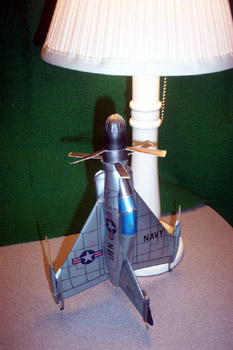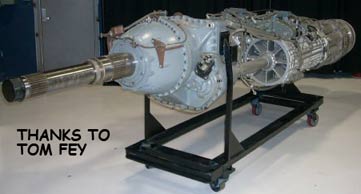


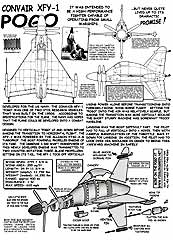
XFY-1 Convair Pogo Vertical Takeoff 'Tail Sitter"
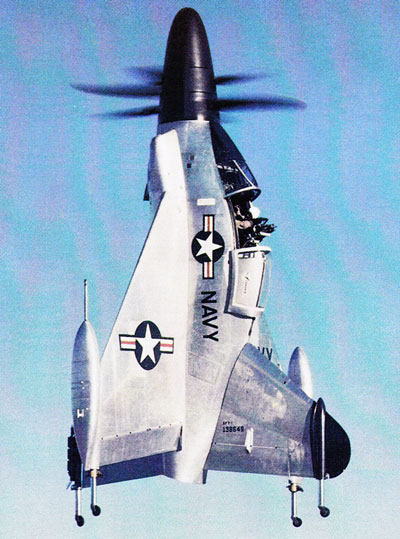
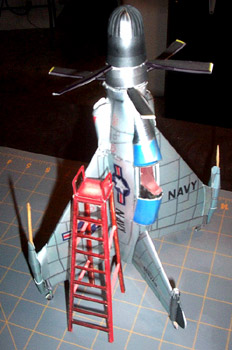 Vertical landing and takeoff have long been a dream of aviation
designers and have presented considerable challenge. It requires
an immense amount of power to get off the ground without the benefit
of wings, and it was only in the years after World War II that powerful
enough engines became available.
Vertical landing and takeoff have long been a dream of aviation
designers and have presented considerable challenge. It requires
an immense amount of power to get off the ground without the benefit
of wings, and it was only in the years after World War II that powerful
enough engines became available.
It was then that some truly strange aircraft took to the skies,
most notable the Convair XFY-1 "Pogo." The XFY-1 was a "tail-sitter,"
using the most powerful turboprop available in the Western world.
The U.S.Navy's Bureau of Aeronautics in 1951, after having ordered
two prototypes of the revolutionary supersonic XF2Y-l seaplane,
issued to Convair a Request for proposals for a single-seat vertical
take-off and landing fighter which could be used to escort convoys,
based on cargo vessels which did not have flight decks. The U.S.Navy
accepted Convair's submission and in March 1951 ordered the XFY-1
as well as placing an order for Lockheed's project, which was designated
XFV-1.
This Pogo is well, Weird!! I love it!....George R.
The Pogo is amazing. I love all the facts on your instruction and model pages. It is really great to be able to do something fun and educational with the kids. You guys are the best!...Peter H.
The improved layout of the propellers -first seen on the B-17 - continues. It works wonderfully. I made a spacer the same size as the propeller hub from cardboard with notches cut in it for the ends of flat toothpicks to serve as stiffeners for the blades. Slow work making them, but it does the job. John T
Oh boy! Oh boy! I am bouncing up and down over the pogo.H-m-m-m-m-m-m-m-m....nice visual. Hope I don't whack my head on the ceiling like the last time. fp
Dear Fiddlers Green,
While looking up a date on the XFY-1 Convair "Pogo" I saw that you had a "picture" of the Allison turboprop engine. Actually what you have is not an Allison engine, nor a T-40 as used in the aircraft. Otherwise it is a great article!
Dave Newill, President, Rolls-Royce Heritage Trust, Allison Branch, Inc. (all fixed Dave Thanks!)
Convair XFY-1 "POGO"
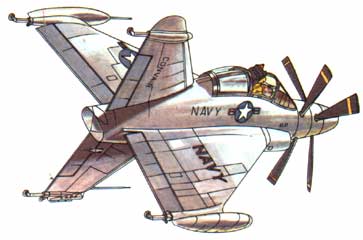
The U.S.Navy's Bureau of Aeronautics in 1951, after having ordered two prototypes of the revolutionary supersonic XF2Y-l seaplane, issued a request for proposals for a single-seat vertical take-off and landing fighter which could be used to escort convoys, based on cargo vessels which did not have flight decks. The U.S.Navy accepted Convair's submission and in March 1951 ordered the XFY-1 as well as placing an order for Lockheed's project, which was designated XFV-1.
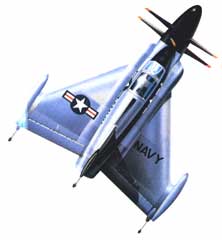 The Pogo, as the XFY-1 was called, had
a short, stubby fuselage, on which were mounted two near-delta
wings and two enormous fins, one ventral and one dorsal, giving
the arrangement a cruciform appearance. A small wheel was attached
to the apices of all four of these surfaces and when parked, the
aircraft rested, nose in the air, on these four wheels. Power
was supplied by a 5,850hp Allison YT40-A-6 turboprop engine, driving
two coaxial propellers and a large spinner. The ventral fin could
be jettisoned in flight were it necessary to make an emergency
belly landing (on land or sea). By March 1954 the prototype was completed and taken
to Moffett Field naval base in California where, inside an enormous
hangar, braced by a special rig to prevent any possible chance
of the aircraft toppling over, powered tethered tests were carried
out, during which the aircraft was allowed to lift itself a few
inches off the ground.
The Pogo, as the XFY-1 was called, had
a short, stubby fuselage, on which were mounted two near-delta
wings and two enormous fins, one ventral and one dorsal, giving
the arrangement a cruciform appearance. A small wheel was attached
to the apices of all four of these surfaces and when parked, the
aircraft rested, nose in the air, on these four wheels. Power
was supplied by a 5,850hp Allison YT40-A-6 turboprop engine, driving
two coaxial propellers and a large spinner. The ventral fin could
be jettisoned in flight were it necessary to make an emergency
belly landing (on land or sea). By March 1954 the prototype was completed and taken
to Moffett Field naval base in California where, inside an enormous
hangar, braced by a special rig to prevent any possible chance
of the aircraft toppling over, powered tethered tests were carried
out, during which the aircraft was allowed to lift itself a few
inches off the ground.
Finally on August 1, 1954, the XFY-1 was taken outside the hangar and it was up to the test pilot, J.F. (Skeet's) Coleman to make the first vertical take-off; the plane rose to a height of 40 feet, followed by a trouble-free landing. The XFY-1 was then taken to the Naval Auxiliary Air Station at Brown Field for further testing and this culminated, on November 4, in the first complete experimental flight: the aircraft achieved vertical take-off, subsequently carried out the transition from vertical to horizontal flight and flew normally for about 20 minutes, before lowering itself gently to the ground. Skeet's Coleman was very enthusiastic about the XFY-1 and his verdict was that he found it easier to handle and more maneuverable than any other plane he had ever flown.
There was no doubt that the XFY-1 project was a success so far but the U.S.Navy did not feel it was a practicable proposition for series production and deployment as a warplane at that point. There were still many problems to overcome; not least the pilot's uncomfortable accommodation as well as the need to develop a zero altitude ejector seat for his safety. Before the test program was halted, however, the XFY-1 flew for a total of 40 hours and earned itself the distinction of being the first vertical take-off and landing aircraft to fly successfully in the history of aviation.
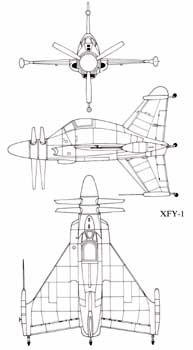 |
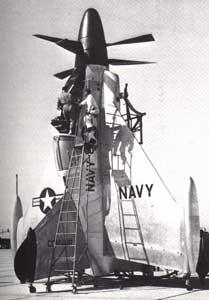 |
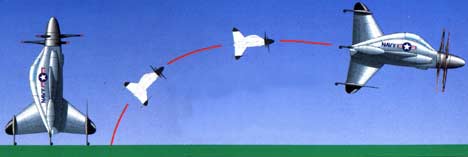 |
|||
HORIZONTAL
FLIGHT
|
|||
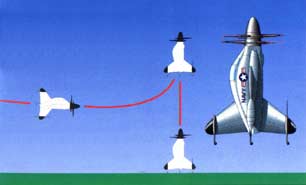 |
|||
LANDING
|
|||
The Convair XFY-1 Pogo was an experimental vertical takeoff aircraft of the 1950s. It was a result of a proposal issued by the Navy in 1948 for an aircraft capable of vertical takeoff and landing (VTOL) aboard platforms mounted on the afterdecks of conventional ships. In 1950, this requirement was revised to call for a research aircraft capable of evolving into a VTOL ship-based convoy escort fighter. In March of 1951, three prototypes were ordered from Convair under the designation XFY-1. A similar aircraft was also ordered from Lockheed under the designation XFV-1.
The XFY-1 sat on its tail for landings and takeoffs. It had a large delta wing with two pods at the extreme and two large vertical fins above and below the fuselage. The aircraft rested on a set of small castoring wheels at the tips of the wing and fin. At takeoff, the engines ran up to full power and the aircraft ascended vertically, then when it reached a safe altitude it gradually nosed over into conventional horizontal flight. At landing, the aircraft approached the landing pad while pitched up into a nose-high position and then descended to the ground under gradually reduced power. If an emergency were to occur, the ventral fin could be jettisoned so that the aircraft could make a crash-landing in conventional, wing-supported mode.
The XFY-1 was powered by an Allison YT40-A-6 turboprop (which consisted of two T38 turboprops coupled together) driving a pair of Curtiss-Wright 16-foot three-bladed counter-rotating propellers in the nose. The engine offered a power of 5500 shp. The air intakes for the engines were located in the extended roots of the delta wing, and the exhaust was in the extreme tail.
The single pilot sat underneath a cockpit canopy which slid toward the rear. The ejector seat was mounted on gimbals and tilted 45 degrees when the aircraft was in the vertical position. Entry to or exit from the cockpit required a special ladder, and was by all accounts rather awkward. During takeoffs and landings, the canopy was slid to the rear to give the pilot a better view.
The proposed armament (never actually fitted) was four 20-mm cannon fitted in the two wingtip pods. Alternatively, 48 2 3/4-inch folding-fin rockets could be fitted.
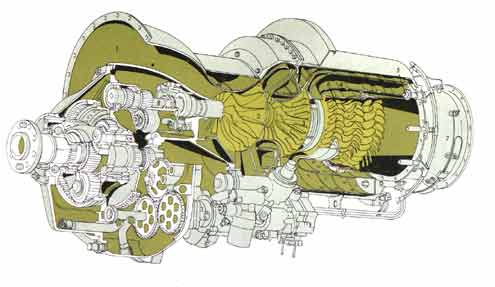 This is a diagram of a jet turbine and not the actual Allison that was used in the Pogo |
|
Allison T-40A Engine..
T40-engines on the XP5Y-1 prototype in 1950
|
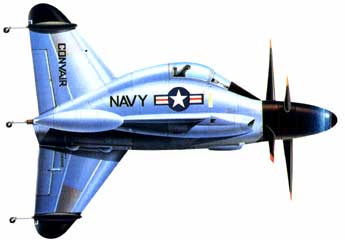 Before attempting the first flights, the prototype ..XFY-1 was attached to a complex tether system inside a huge
hangar at NAS Moffett Field, California that allowed the aircraft
to move up or down freely, but severely limited the lateral
displacement. During the summer of 1954, test pilot James F.
"Skeet's" Coleman made several tethered flights in
this system. The first un-tethered vertical flight was made
on August 1, 1954. During the next two days, several vertical
hovering flights were made during which the aircraft reached
altitudes as high as 150 feet. The aircraft was then returned
to San Diego for further tests at NAAS Brown Field. The first
successful transition to horizontal flight took place on November
2, 1954, during which the XFY-1 flew horizontally for 20 minutes
before coming back and landing inside a 50-foot square. This
was the first successful VTOL flight in history in an aircraft
that was not a helicopter or an autogiro. For this feat,
Coleman was awarded the Harmon Trophy.
Before attempting the first flights, the prototype ..XFY-1 was attached to a complex tether system inside a huge
hangar at NAS Moffett Field, California that allowed the aircraft
to move up or down freely, but severely limited the lateral
displacement. During the summer of 1954, test pilot James F.
"Skeet's" Coleman made several tethered flights in
this system. The first un-tethered vertical flight was made
on August 1, 1954. During the next two days, several vertical
hovering flights were made during which the aircraft reached
altitudes as high as 150 feet. The aircraft was then returned
to San Diego for further tests at NAAS Brown Field. The first
successful transition to horizontal flight took place on November
2, 1954, during which the XFY-1 flew horizontally for 20 minutes
before coming back and landing inside a 50-foot square. This
was the first successful VTOL flight in history in an aircraft
that was not a helicopter or an autogiro. For this feat,
Coleman was awarded the Harmon Trophy.
Unfortunately, the XFY-1 was difficult to land because of a poor view from the cockpit of the landing area and the unusual pilot posture. The landing operation would probably have been difficult if not impossible for a pilot of ordinary ability to perform on a small deck aboard ship, especially in rough seas where the deck was pitching back and forth. In addition, the T40 turboprop was mechanically complex and was thoroughly unreliable and subject to frequent breakdowns. The T40 was, in fact, the cause of the failure of several combat aircraft projects of the era. In addition, by this time the performance of the XFY-1 was quite a bit less than that of conventional jet aircraft, and would probably not have been able to hold its own in air-to-air combat. For this reason, the XFY-1 program was cancelled after only 40 hours of flight testing.
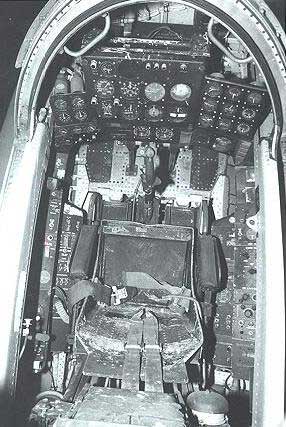 |
Convair XFY-1 Pogo Cockpit. |
Specifications
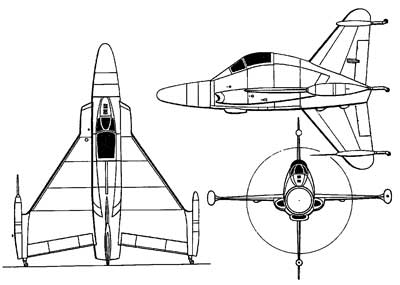 |
|
Technical data: XFY-1 Type: Vtol fighter Crew: I First order: 2 Order date: 3/31/1951 First flight: 8/1/1954. Power plant: Allison YT40-A-6, 5,850 hp. Max wingspan: 27ft 7 3/4in Wing area: 355 sq ft Length: 34ft 11 3/4in Height: 22ft 1 in |
Gross weight: 16,2501b Max speed at sea level: 474 mph Max speed at: 15,000ft: 610 mph Max speed at: 35,000ft: 592 mph Climb: 20,000ft / 2.7min Climb: 10, 500ft / 1 min Service ceiling: 43,700 ft Fuel capacity: 576US gal. Armament: 4 x 20 mm (not installed) Two contra-rotating coaxial, three-bladed propellers. |
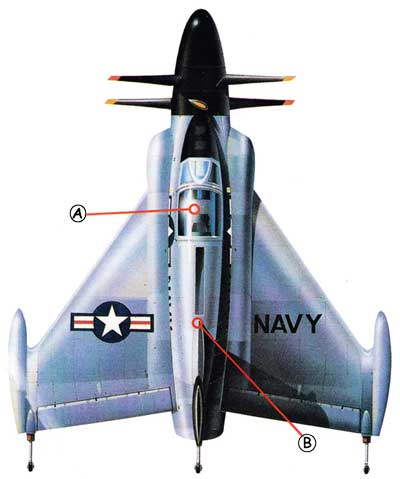 |
|
| A: For vertical flight, the pilot's seat rotates forward 45 deg. He still had to look over his shoulder to judge the distance to the ground, an awkward procedure that added considerably to the pilot's workload on landing. | B: Control in normal flight was provided by full-span ailerons and large rudders on both the dorsal and ventral fins. During vertical flight the propeller slipstream was deflected over these surfaces for control. |
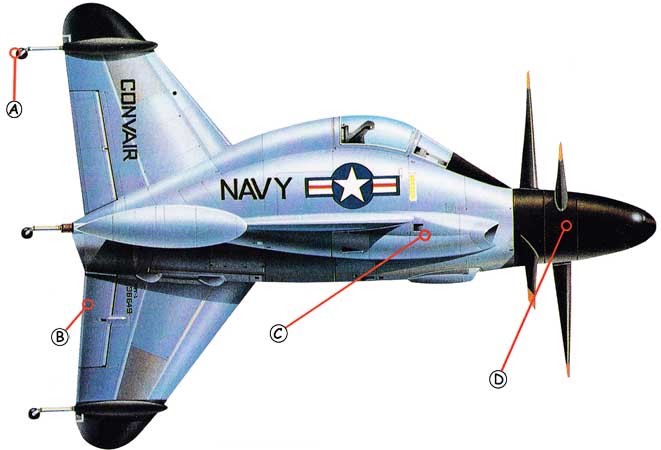 |
|||
| A: Small castoring wheels on strong single-strut shock absorbers were fitted to the wing and fin tips. These give a stable base for landing, which was eventually intended to be made on a heaving ship's deck. | B: The "Pogo" could not be landed conventionally. The large delta wings were mated with huge upper and lower vertical fins to produce a cruciform layout A normal undercarriage would have been impossibly cumbersome. | C: The Allison YT-40-A-6 turboprop was the most powerful engine of its type in the West, generating over 5,500 horsepower. A small amount of jet thrust from the tailpipe was added to that. | D: Power from the Allison engine was delivered to two three-blade contra-rotating propellers. Without them, the torque from a single propeller would have made control during vertical takeoff or landing impossible. |



